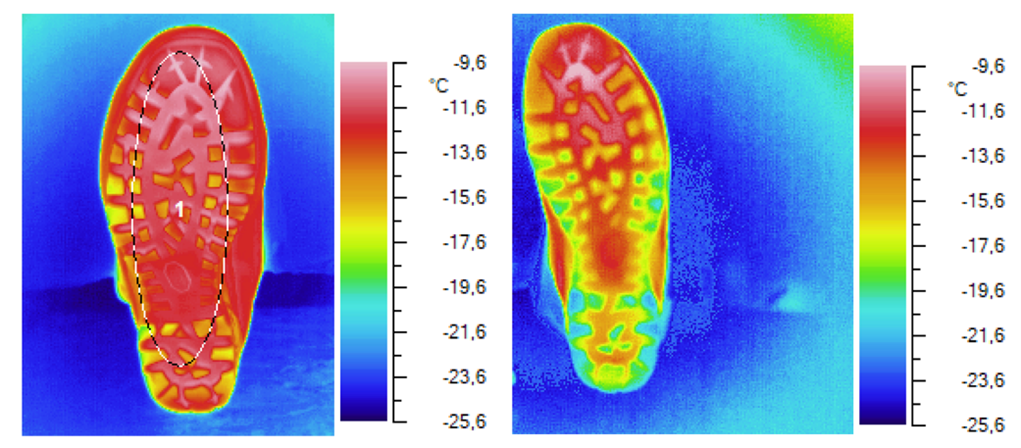Definition of a thermal comfort rating scale for mountaneering boots
DOI:
https://doi.org/10.25367/cdatp.2023.4.p110-119Abstract
This study investigates the thermal insulation and moisture management of three types of mountaneering boots and simulated hiking activities under controlled environmental conditions with two elite athletes. Temperature and humidity were determined with six wireless probes placed on the most exposed parts of the foot (hallux, middle toe, little toe, dorsum, ankle and sole). Thermal images were taken to record the thermal insulation of each sample. Methodologically, the study aims to simulate every movement and activity of alpinism in order to realistically evaluate the conditions of use of this kind of footwear (also taking into account the lacing pressure exerted on the foot). Based on the results obtained, in a further step it will be possible to define the best solution in terms of combination of materials by creating a comfort scale for hiking boots.
References
Lopardo, G. Un Modello Matematico di Termoregolazione del Corpo Umano, PhD thesis, Università degli studi di Salerno, 2011.
Kuklane, K.; Ueno, S.; Sawada, S.I.; Holmér, I. Testing Cold Protection According to EN ISO 20344: Is There Any Professional Footwear That Does Not Pass? Ann. Occup. Hyg. 2009, 53, 63-68. DOI: https://doi.org/10.1093/annhyg/men074.
Kuklane, K. Protection of Feet in Cold Exposure. Industrial Health 2009, 47, 242-253. DOI: https://doi.org/10.2486/indhealth.47.242.
Arezes, P.M.; Neves, M.M.; Teixeira, S.F.; Leão, C.P.; Cunha, J.L. Testing Thermal Comfort of Trekking Boots: An Objective and Subjective Evaluation. Applied Ergonomics 2013, 44, 557565. DOI: https://doi.org/10.1016/j.apergo.2012.11.007.
West, A.M.; Tarrier, J.; Hodder, S.; Havenith, G. Sweat Distribution and Perceived Wetness across the Human Foot: The Effect of Shoes and Exercise Intensity. Ergonomics 2019, 62, 1450-1461. DOI: https://doi.org/10.1080/00140139.2019.1657185.
Havenith, G.; Richards, M.G.; Xiaoxin, W.; Brode, P.; Candas, V.; Den Hartog, E.; Holmér, I.; Kuklane, K.; Meinander, H.; Nocker, W. Apparent Latent Heat of Evaporation from Clothing: Attenuation and “Heat Pipe” Effects. J. Appl. Physiol. 2008, 104, 142-149. DOI: https://doi.org/10.1152/japplphysiol.00612.2007.
International Standardization Organization UNI EN ISO 28802:2012 – Ergonomics of the Physical Environment — Assessment of Environments by Means of an Environmental Survey Involving Physical Measurements of the Environment and Subjective Responses of People (ISO 28802:2012) 2012.
Babič, M.; Lenarčič, J.; Žlajpah, L.; Taylor, N.A.S.; Mekjavić, I.B. A Device for Simulating the Thermoregulatory Responses of the Foot: Estimation of Footwear Insulation and Evaporative Resistance. Strojniški vestnik – Journal of Mechanical Engineering 2008, 54, 628-638.
Kuklane, K.; Holmér, I. Effect of Sweating on Insulation of Footwear. International Journal Of Occupational Safety And Ergonomics 1998, 4, 123-136. DOI: https://doi.org/10.1080/10803548.1998.11076385.
Smith, C.J.; Machado - Moreira, C.A.; Plant, G.; Hodder, S.; Havenith, G.; Taylor, N.A.S. Design Data For Footwear: Sweating Distribution On The Human Foot. International Journal of Clothing Science and Technology 2013, 5, 43-58. DOI: https://doi.org/10.1108/09556221311292200.
Puszkarz, A.K.; Usupov, A. The Study of Footwear Thermal Insulation Using Thermography and the Finite Volume Method. International Journal of Thermophysics 2019, 40, 45. DOI: https://doi.org/10.1007/s10765-019-2509-1.
Heus, R.; Schols, E.; Kistemaker, L. Frostbite in Ski Boots for Marines. Prevention of Cold Injuries 2005, 7, 1-8.
Bogerd, C.P.; Brühwiler, P.A.; Rossi, R.A. Heat Loss and Moisture Retention Variations of Boot Membranes and Sock Fabrics: A Foot Manikin Study. International Journal of Industrial Ergonomics 2012, 42, 212-218. DOI: https://doi.org/10.1016/j.ergon.2012.01.001.
Kalev Kuklane; Ingvar, H.; Giesbrecht, G. Change in Footwear Insulation at Various Sweating Rates. Appl. Human Sci. 1999, 18, 161-168. DOI: https://doi.org/10.2114/jpa.18.161.

Downloads
Published
How to Cite
Issue
Section
License
Copyright (c) 2023 Eleonora Bianca, Francesca Dotti, Ada Ferri

This work is licensed under a Creative Commons Attribution-NonCommercial-NoDerivatives 4.0 International License.





